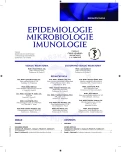Chřipka u dětské populace v Istanbulu – zkušenosti jednoho centra 2009–2014
Authors:
Selda Hançerli Törün 1; Esin Karakılıç 2; Hacer Aktürk 1; Murat Sütçü 1; Metin Uysalol 3; Meral Cıplak 4; Selim Badur 4; Nuran Salman 1; Ayper Somer 1
Authors‘ workplace:
Division of Pediatric Infectious Diseases, Istanbul University, Istanbul Faculty of Medicinei Istanbul, Turkey
1; Division of Pediatrics, Istanbul University, Istanbul Faculty of Medicinei Istanbul, Turkey
2; Division of Pediatric Emergency, Department of Pediatrics, Istanbul University, Istanbul Faculty of Medicinei Istanbul, Turkey
3; Virology and Fundamental Immunology Unit, Department of Microbiology and Clinical Microbiology, Istanbul University, Istanbul Faculty of Medicinei Istanbul, Turkey
4
Published in:
Epidemiol. Mikrobiol. Imunol. 65, 2016, č. 1, s. 46-50
Category:
Original Papers
Overview
Úvod:
Cílem studie bylo hodnocení klinických charakteristik u dětských pacientů s chřipkovou infekcí.
Materiál a metody:
Do studie byli zařazeni pacienti s potvrzenou diagnózou chřipky hospitalizovaní v období od října 2009 do května 2014.
Výsledky:
Průměrný věk pacientů byl 66 ± 53 měsíců (1–204 měsíců). 54 % pacientů mělo nějaké chronické základní onemocnění. U 24 pacientů bylo třeba použít umělou plicní ventilaci a jeden dvouměsíční pacient s onemocněním jater zemřel. Kromě sezony 2009–2010, trpěli všichni pacienti, kteří museli být převedeni na umělou plicní ventilaci, nějakým základním onemocněním. V jednotlivých sezonách došlo k hospitalizacím v těchto měsících: prosinec až únor 2010–2011 a leden až březen 2011–2012 a 2012–2013. U pacientů s chřipkou typu A se často vyskytovaly křeče a chřipka typu B byla diagnostikována častěji u starších dětí (p = 0,024). K nejčastějším příznakům u dětských pacientů patřila horečka a kašel.
Závěr:
Je zřejmé, že ochrana proti cirkulujícím chřipkovým virům musí vycházet ze strategie očkování rizikových skupin zaměřené na děti školního věku a na děti se základním onemocněním, zejména neurologické a plicní povahy.
Klíčová slova:
virus chřipky – děti – klinické charakteristiky
Sources
1. Ampofo K, Gesteland PH, Bender J, et al. Epidemiology, complications, and cost of hospitalization in children with laboratory-confirmed influenza infection. Pediatrics, 2006; 118:2409–2417.
2. Committee on Infectious Diseases; American Academy Pediatrics. Recommendations for prevention and control of influenza in children (2014–2015). Pediatrics, 134:1503–1519.
3. Daley AJ, Nallusamy R, Isaacs D. Comparison of influenza A and influenza B virus infection in hospitalized children. J Paediatr Child Health, 2000;36(4):332–335.
4. Dawood F, Subbarao K, Fiore A. Influenza viruses. In: Long SS, Pickering LK, Prober CG, (Eds). Principles and Practice of Pediatric Infectious Diseases. 4nd ed. Philadelphia: Churchill Livingstone, 2012, p. 1153–1172.
5. Fiore A, Fry A, Shay D, et al. Centers for Disease Control and Prevention (CDC). Antiviral agents for the treatment and chemoprophylaxis of influenza – recommendations of the Advisory Committee on Immunization Practices (ACIP). MMWR Recomm Rep, 2011;60:1–24.
6. Harper SA, Bradley JS, Englund JA, et al. Seasonal influenza in adults and children – diagnosis, treatment, chemoprophylaxis, and institutional outbreak management: clinical practice guidelines of the Infectious Diseases Society of America. Clin Infect Dis, 2009;48:1003.
7. Harper SA, Fukuda K, Uyeki TM, et al. Prevention and control of influenza. Recommendations of the Advisory Committee on Immunization Practices (ACIP). MMWR Recomm Rep, 2005;54:1–40.
8. Hu JJ, Kao CL, Lee PI, et al. Clinical features of influenza A and B in children and association with myositis. J Microbiol Immunol Infect, 2004;37:95–98.
9. Influenza (Seasonal) Fact sheet. WHO int. March 2014. Retrieved 25 November 2014.
10. Keren R, Zaoutis TE, Bridges CB, et al. Neurological and neuromuscular disease as a risk factor for respiratory failure in children hospitalized with influenza infection. JAMA,2005; 294:2188–2194.
11. Nicholson KG, Wood JM, Zambon M. Influenza. Lancet, 2003;362:1733–1745.
12. Meral Ciplak, Grip Platformu. Influenza vaccination in Turkey: Prevalence of risk groups, current vaccination status, factors influencing vaccine uptake and steps taken to increase vaccination rate. Vaccine, 2013;31:518–5238.
13. Wang YH, Huang YC, Chang LY, et al. Clinical characteristics of children with influenza A virus infection requiring hospitalization. J Microbiol Immunol Infect, 2003;36:111–116.
14. Webster RG, Bean WJ, Gorman OT, et al. Evolution and ecology of influenza A viruses. Microbiol Rev, 1992;56:152–179.
15. http://www.who.int/csr/resources/publications/swineflu/CDCrealtimeRTPCRprotocol_20090428.pdf?ua=1 Accessed: December 23, 2014)
Labels
Hygiene and epidemiology Medical virology Clinical microbiologyArticle was published in
Epidemiology, Microbiology, Immunology

2016 Issue 1
Most read in this issue
- Antibiotická léčba klostridiové kolitidy
- Infekční a další somatická komorbidita problémových uživatelů drog – výsledky průřezové studie s lékařským vyšetřením
- Virus hepatitidy E
- Posuzování invalidity u infekčních onemocnění
